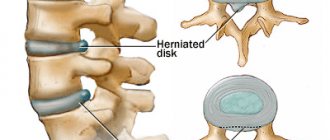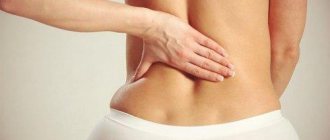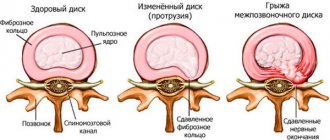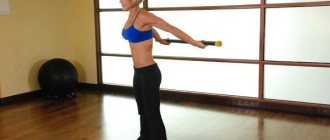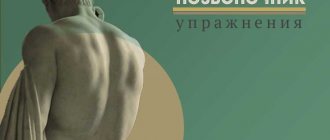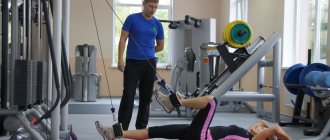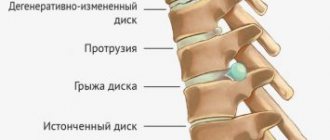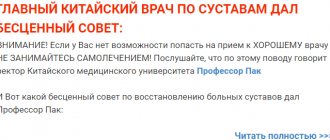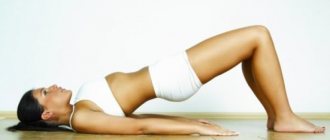The therapeutic effect of gymnastics for the cervical spine
Therapeutic gymnastics is a fairly well-known method of medical rehabilitation, based on the use of physical exercises to cure or eliminate the consequences of any disease. Currently, many doctors consider gymnastics as an integral part of the treatment of chronic diseases, which is as effective as the effects of medications.
The main goals and essence of therapeutic exercises
Like any therapeutic event, gymnastics has several goals. All of them are aimed at improving the general condition of the patient, getting rid of the problem and further prevention.
The goals of therapeutic physical gymnastics:
- strengthening the muscular framework of the neck;
The muscular frame of the neck is the main point of application of therapeutic exercises - stabilization of the cervical spine;
- prevention of disease relapse;
- reduction of pain syndrome;
- consolidation of the results obtained.
Effects of daily exercise
All effects from the use of therapeutic exercises can be divided into short-term (occurring immediately at the time of completing tasks) and long-term (remote effects from training).
To achieve long-term effects, you must perform the exercises regularly without skipping classes.
Effects of therapeutic exercises - table
| Short term effects | Long term effects |
|
|
A little about the system
Vertebrology is a branch of medicine that specializes in the study of the spine and its treatment. And one of the main postulates in therapy, both for the back and absolutely all joints of the body, is the need for physical activity. Vertebrologist specialist Igor Borshchenko has developed an effective system of isometric gymnastics for the treatment of the spine, which is based on simplicity, accessibility and safety for any patient.
There are categories of people for whom Borshchenko’s isometric gymnastics is especially indicated. These include the following:
- Elderly people. At the age of 50-60, all joints undergo certain changes, and this applies in particular to the vertebral discs. The loads to which the musculoskeletal system is exposed cause degenerative processes in cartilaginous tissues. Only competent physical activity will help prevent them.
- Overweight people. Excess weight puts excessive pressure on joints, causing them to become damaged and inflamed. Poor nutrition, excessive consumption of sweet, spicy, fatty foods, provokes metabolic disorders inside the joints.
- People who lead a sedentary and inactive lifestyle. If a person sits often and for a long time, the joints do not react to this in the best way. This especially applies to the cervical region. As a result, the muscles contract unnaturally, and the structure of the joints and intervertebral discs deteriorates. Without physical activity, muscles cannot help reduce stress on cartilage, ligaments and tendons.
- Professional athletes. Their joints are constantly under pressure from sudden movements and heavy weights used. The same applies to newcomers to sports, especially those who do not follow safety precautions, do not warm up before training and immediately give themselves heavy loads.
- Those who do heavy physical labor. Despite the fact that such people have a fairly dense muscular frame, their joints endure constant tension. They also often do not pay attention to safety precautions, which has a negative impact.
- Those who have recently undergone injury or joint surgery. For the rehabilitation period, Borshchenko’s gymnastics is ideal, since its effect on cartilage and muscles is low-intensity.
Therapeutic positional gymnastics according to the Igor Borshchenko system is successfully used to treat the following diseases:
Osteochondrosis. The principle of action is that exercise improves blood circulation in cartilage tissue. The latter receive more nutritional components, and the necessary level of elasticity is restored. Pinched nerve roots
In this case, it is especially important to increase the distance between the vertebrae. And this is impossible until the muscles sufficiently support the bones of the back.
Hernias and protrusions. Thanks to strong muscles, the pressure on the affected intervertebral disc is reduced. Arthrosis and arthritis. In this case, Dr. Borshchenko’s isometric gymnastics for the shoulder or other joint will be aimed at improving metabolic processes in the tissues of the joints, which will help eliminate inflammation and promote the restoration of cartilage tissue. Curvature of the spine. In this case, Borshchenko's method is used as an auxiliary method. Isometric muscle tension allows you to return the vertebrae to their correct position.
Who should not do therapeutic exercises?
Like any therapeutic agent, therapeutic physical culture is not indicated for everyone . For some groups of people, it is absolutely contraindicated to perform any kind of exercise, as this can provoke an exacerbation of the disease and complicate its course. In cases where the supposed harm from the exercise may outweigh the benefits, therapeutic exercises are not prescribed.
To find out if you are at risk, you should consult your doctor. The therapist will issue a certificate of health and determine its group, which will allow the medical rehabilitation specialist to conclude that the patient can perform physical exercises.
Engaging in physical therapy is contraindicated in the following conditions:
- increased body temperature;
- intense pain syndrome that is not eliminated by non-narcotic analgesics and anti-inflammatory drugs;
- dehydration and general exhaustion of the body (cachexia);
- the first signs of pulmonary edema;
With edema, fluid accumulates in the air cavities of the lungs - the alveoli. - acute cerebrovascular accidents (ischemic or hemorrhagic cerebral infarction);
- acute respiratory failure;
- chronic respiratory failure of the fourth degree;
- chronic heart failure of the third and fourth degree;
Chronic circulatory failure is a consequence of heart disease - disintegration of a cancerous tumor;
- recent infectious disease;
- tendency to form blood clots (thrombosis);
- recently suffered a major myocardial infarction;
Myocardial infarction - an area of dead heart muscle due to the closure of the lumen of a vessel by a thrombus or plaque - severe forms of dementia;
- severe mental illness.
How exactly do exercises help?
Regular exercise therapy for cervical osteochondrosis makes muscles stronger, relieves muscle spasms, increases blood circulation, and improves the condition of intervertebral discs. If you choose the right set of exercises, it will help get rid of the unpleasant sensations that often accompany cervical osteochondrosis. These include headaches, pain in the shoulders and arms, and dizziness.
It is not always possible to contact a specialist. In principle, it is not a problem to do physical therapy on your own. These exercises can be easily done at home. There are simple sets of exercises that even a beginner can handle. One of these complexes will be presented below.
What should not be forgotten when performing exercise therapy for cervical osteochondrosis? When performing exercises from the physical therapy complex for cervical osteochondrosis, do not forget the following rules. This is important for your own safety. Exercises will only be effective if done correctly. Additionally, doing the exercises incorrectly can cause serious harm to your spine.
Indications and contraindications for prescribing exercises
The neck is a very thin and sensitive part of the human body. If its structures are damaged, there is a possibility of complete paralysis. That is why it is worth prescribing special exercises to strengthen the muscular corset only to those who really need it and have no contraindications for taking a course of exercise therapy.
Indications for prescribing exercises:
- cervical osteochondrosis of varying severity;
- vegetative-vascular dystonia;
- migraines and frequent headaches of varying degrees of intensity;
The basis of migraine is the expansion and pulsation of the blood vessels of the brain and its membranes - recovery from injuries and spinal fractures;
- recovery after prolonged wearing of a corset;
- sleep disorders: increased drowsiness, lethargy or insomnia;
- chronic cervicalgia;
- dizziness of peripheral and centralized nature;
- rachiocampsis;
Curvature of the spine leads to pinched nerves and other symptoms - recovery from paralysis;
- periodic disturbances of memory and concentration;
- chronic fatigue syndrome.
In order to prevent the occurrence of chronic diseases, it is recommended to carry out therapeutic exercises in the following cases:
- regular sports training;
- professional training in martial arts;
- sedentary lifestyle;
- long-term work at the computer (six or more hours a day);
- age over twenty-five years;
- presence of spinal diseases in close relatives;
- obesity.
Contraindications to prescribing exercises:
- exacerbation of cervical osteochondrosis;
- tumor lesion of the spine or spinal cord;
- foreign body in close proximity to blood vessels and nerves;
- arthrosis of the hip joint;
- herniation or protrusion of intervertebral discs;
A herniated disc occurs when the annulus fibrosus ruptures. - unknown cause of pain.
Isometric gymnastics for busy people
Sedentary work takes up most of your time, and you simply don’t have time to take care of your own health, although constant back and joint pain are your constant companions?
Start practicing using Dr. Borshchenko’s unique isometric method. Affordable and effective exercises can be performed right at your workplace, devoting only about 10 minutes a day to them. By freezing in special ergonomic positions, you will not overload your joints and vertebrae, which will help you avoid injuries and sprains.
Isometric gymnastics will not require much effort from you - only muscle tension in special poses and movements of small amplitude. You can perform them at any time and anywhere, it is better to do it daily. The result will pleasantly surprise you - you will forget about pain in the spine and joints!
How often do we hear from doctors: “We need to strengthen the spine... We need to do gymnastics and exercises... Now strengthen your back!” Patients echo them: “I’m ready to study. Show me what exercises to do. Tomorrow I’ll sign up for a fitness club!”
Indeed, most people intuitively understand that health is associated with certain physical activity, and it is advisable to obtain it during special classes. It is at this moment that many questions arise that can become an insurmountable obstacle to health.
Preparing to do the exercises
In order for gymnastics to be effective and not bring unpleasant consequences, a certain ritual of action should be carried out. Correct technique and compliance with safety precautions are the main key to successful exercise.
Conditions for performing exercises
Doing therapeutic exercises in inappropriate conditions can result in unpleasant consequences: increased fatigue, injury. To avoid this, you need to prepare a room and special clothes for performing gymnastics.
Conditions for competent conduct of physical therapy:
- well-lit room;
- large area of the room;
- special gymnastic mat;
- comfortable sportswear and shoes that fit;
- ventilated room with ventilation;
- mirror to control the correctness of the exercises.
If all conditions are met, you can achieve maximum results in a short time
Safety precautions
As with any sport, some unpleasant moments may arise when performing gymnastic exercises. They can be avoided by following safety precautions. With a competent approach to performing exercises, the risk of injury is minimized.
A few simple rules that will help you avoid unpleasant consequences:
- warm-up before starting classes;
Warm-up is the key to a successful workout - performing exercises slowly and smoothly;
- rest and pause between approaches;
- strict order of exercises;
- precise execution of exercises in accordance with the task;
- no slippery surfaces;
- the presence of a person who can provide backup during the exercise.
Lower back pain after lifting weights
If a person’s back begins to hurt when lifting weights, this indicates a weakening of the spine due to constant stress. Typically, pain in this case appears in the area of the right side of the lower back. But unpleasant sensations do not always appear in the lower back. Often pain appears in the chest or back.
The causes of back pain can be completely varied. One of them is curvature of the spine (scoliosis). Curvature may occur due to frequent wearing of heavy backpacks, bags, bags. This causes muscle imbalance. Also, causes of back pain include sudden heavy lifting or failure to follow safety precautions.
Lifting a heavy object located on one side can also cause back pain. The back may begin to hurt when carrying a heavy object with outstretched arms. It is important to ensure that the load is pressed tightly to the body. If this does not happen, then additional stress is placed on the spine. This will subsequently have a negative impact on human health.
If pain in the back occurs when lifting heavy objects, then you need to visit a doctor. Self-medication will most likely not lead to anything good, and on the contrary, will have a negative effect. The consequences of improper self-medication can be very serious. As a result, the diagnosis may be an intervertebral hernia, which can only be eliminated through surgery.
If back pain occurs while a person is moving with a heavy object, the load should be lowered immediately. You need to continue moving only after the pain disappears. Of course, many will be interested in the question of how long you can continue moving. The duration of a person’s movement depends on the training and integrity of the spinal column. People with an athletic build can handle heavy lifting much better with minimal harm to their health.
First of all, serious physical activity should be avoided. Try not to take painkillers unless absolutely necessary, as these drugs dramatically worsen your stomach condition.
If your health allows, maintain moderate activity: stretching exercises, walking, swimming. To prevent pain from getting worse, consult a specialist to choose the optimal set of exercises, or exercise under the supervision of a physician instructor.
Remember that any severe pain is the body’s way of communicating about a disruption in its functioning. You have the opportunity to respond to the problem in a timely manner and begin to treat it. In case of back pain, you should contact a neurologist or orthopedist-traumatologist.
Many spinal diseases develop over years to a stage when it is no longer possible to completely eliminate the pathology. Therefore, the sooner you can take care of your health, the more effective the result will be.
People say that this is a lumbago, or a manifestation of lumbosacral radiculitis. You cannot lift more than 5 kg. When lifting heavy objects, the vertebrae in the lumbar region are brought closer together and the nerve endings are pinched. This is where the pain comes from. You need to lift correctly: without bending towards the object you want to lift. and squatting and standing up with an object in your hands, while keeping a straight spine as if you had a jug on your head.
This is treated by stretching the spine, that is, lying in bed, pull your hands behind your head, and point your toes towards you. Stretch. like a cat. Rub the sore spot with warming ointment Capsicam or any other (there are a lot of ointments in the pharmacy). From experience, I advise you to pour hot water into a flat glass bottle and warm the sore spot for 20-30 minutes. Then wrap it in a woolen scarf. Gradually everything will pass. Get well!
the author of the question chose this answer as the best
add to favorites link thank
This means that the weakened spine could not withstand the stress associated with heavy lifting.
– lifting and carrying heavy things on one side (bags, backpacks, etc.), causing muscle imbalance.
– lifting weights sharply (this can also cause pain in the cervical region).
– location of the lifted object on the side
– carrying heavy objects with outstretched arms
Use diclac (dilofenac) ointment or finalgon. Wrap the sore spot with a scarf. Avoid exertion while the pain remains, try to lie down for the first two days. but not on a soft surface. Sitting less.
There are also exercises designed to relieve pain: get on all fours and then slowly sit on your heels, without lifting your hands from the floor. Exercise kitty. when, standing on all fours, your back is either arched or bent.
If your back pain does not go away after a week, you should definitely see a doctor.
Most likely, this means that you have not trained your back muscles for a long time and the load on the lower back was done abruptly and without warming up. The position of your back is also important when lifting weights. Usually the load is lifted with a straight back.
The first thing you need to do is sit down or lie down so that your back relaxes a little.
And then (for example, before going to bed) you will need to warm up your lower back. A wide heating belt helps a lot in this situation. It can even be made from dog hair (But it is more expensive).
After lifting weights, my back in the lumbar region was very painful. The traumatologist said that it would go away within 2 weeks. Unfortunately, it didn’t go away, and I did a CT scan. Here is the conclusion: degenerative-dystrophic changes, osteochondrosis of the intervertebral discs of the lumbar spine, disc herniation L4-L5 4.2 mm.
Ideally, you should seek advice from a neurologist at the clinic at your place of residence. After examining you, the doctor would prescribe the necessary treatment for you. If it is not possible to see a neurologist, then describe what other illnesses you have had in your life (except for pyelonephritis) and what medications you are allergic to. I will analyze your answers and prescribe the necessary treatment.
As a child, I suffered from chickenpox, whooping cough, measles, mumps, tonsillitis, and bronchitis. I definitely didn’t have hepatitis. After giving birth (the only one) I treated mastopathy, hemorrhoids and colpitis. And, thank God, I didn’t get sick anymore. There is no allergy. Blood pressure is normal, sometimes slightly lower. There were no fractures or dislocations, only bruises. Hospitalizations occurred only in early childhood
You need to find an opportunity to do intramuscular injections. The course of treatment includes: dexamethasone KRKA 1 ml intramuscularly in the morning about 3-5 days after meals, voltaren 75 mg 3 ml intramuscularly after meals 2 times a day for 2 days, then in tablets 50 mg 2 times a day after meals for about 7-10 days, Nucleo-CMP 2 ml intramuscularly for 6 days, then Nucleo-CMP forte 1 caps 2 times a day regardless of food for 15 days, Neurobion or Milgamma 2 ml intramuscularly 10 days, Flugesic or Katadolone 100 mg 1 caps 3 once a day after meals for about 10 days.
Sincerely: Zinchuk Igor Grigorievich
Head of the Dr. Zinchuk Medical Center
If your lower back hurts after lifting weights, you should be concerned about this condition and do not ignore it, since you could have suffered a serious injury. Developing or chronic diseases can manifest themselves in the same way.
Injury
Pain in the lower back after lifting heavy objects indicates that an injury has occurred. In this case, it is important not to delay visiting a neurologist in order to accurately determine how severe the injury is, its possible consequences, and also to provide effective treatment in a timely manner. If you seek medical help in a timely manner, treatment often consists of creating rest, applying ointments and bandages.
Traumatic injuries, when you lift too heavy a load abruptly, can be called differently - “broke your back”, after which you have to think about why your lower back hurts when lifting heavy objects. This means that in the process of physical work a certain group of muscles was damaged, since an exorbitant load was placed on them.
Osteochondrosis
In the presence of osteochondrosis, lower back pain often appears after lifting heavy objects. This disease is characterized by thinning of the cartilage tissue from which the intervertebral discs are formed. Due to this, the spinal column partially loses its shock-absorbing ability, and therefore can withstand much less load.
Radiculitis
If your lower back hurts after lifting weights, what to do largely depends on what caused the development of acute pain. The problem may be radiculitis, which is a pathology of the nerve roots of the spinal cord. This condition requires treatment.
Sharp pain in the lower back when lifting weights may be a consequence of protrusion of nerve tissue, which occurs due to the fact that the integrity of the intervertebral disc is damaged. The intensity of the pain depends on how large the hernial protrusion is. Often pain occurs precisely when lifting weights, since the protrusion appears at the moment of heavy load.
Kidney pain
Often the reason for this condition, in which both men and women experience lower back pain after lifting heavy objects, lies in kidney disease. This could be pyelonephritis or kidney stones, which manifests itself after exercise.
Tuberculosis of bones
Method of execution and stages of exercises
There are a great variety of different techniques that will relieve pain and restore mobility of the cervical spine within several sessions. The principle of any therapeutic therapy is phasing and consistency. If you regularly and accurately perform all the exercises, gradually increasing the load, then after six months there will be no trace of pain in the neck, and as a bonus you will feel excellent, cheerful and fresh in your thoughts in any endeavor.
Neck exercises according to Bubnovsky
Bubnovsky Sergey Mikhailovich is a recognized specialist in the field of traumatology and orthopedics, as well as medical rehabilitation. The course of gymnastic exercises he developed will allow you to restore the tone of the neck muscles, strengthen the tendons and ligaments and get rid of unpleasant sensations in the neck.
To ensure that the effect of the exercises does not keep you waiting, you must strictly follow all the rules of gymnastics. Professor Bubnovsky recommends first consulting with a specialist, and only then resorting to exercises.
Mandatory rules:
- before starting the exercises, you need to perform a light stimulating neck massage, warming up and preparing the muscles for the load with smooth stroking and pinching movements;
- monitor your spine and posture: if your back is positioned incorrectly, exercises can be harmful;
- monitor your breathing: the exercise begins with inhalation, and ends with a return to the starting position at the exit;
- If you experience severe pain, dizziness, nausea and loss of balance, you must immediately stop exercising and call a doctor or trainer.
Six simple exercises from Dr. Bubnovsky that are easy to do at home:
- Starting position: sitting or standing. You need to first tilt your head to one shoulder, hold it for about thirty seconds, and then very smoothly return it to the starting position. Next you need to lean towards the other shoulder. The repetition rate will be ten to fifteen times.
- Starting position: standing, legs wide apart. The head gradually tilts towards the chest, touching it with the chin. After returning to the starting position, you need to slightly stretch your neck. The exercise is repeated up to ten times.
- This exercise helps relieve stress on the spine. The head is tilted back a little (you can use a soft mat or a wall as support), and then turns to the right and left. The exercise should be repeated seven to eight times.
- When performing the third exercise, you need to raise your hands, clasp them together and stretch upward with each turn of your head. The recommended number of repetitions is five times.
- Starting position: sitting. The right hand is placed on the left shoulder. The elbow is set at a right angle to the chest. After this, you need to smoothly turn your head to the right and freeze for thirty seconds. Next, repeat the exercise with your left hand up to fifteen times.
- The final exercise is performed from a standing position. The head is lowered and slowly turns from one shoulder to the other. Repeat five to seven times until the spine is completely relaxed.
The Bubnovsky technique uses tilts and turns of the neck
Video: Doctor Bubnovsky tells how to get rid of neck pain
Isometric muscle strengthening exercises
Isometric exercise sets are based on complete relaxation of the neck muscles without their subsequent contraction. Such loads remove the block caused by compression of blood vessels and nerves. Unpleasant sensations will begin to disappear a few minutes after the start of classes.
There are a great variety of isometric exercises, but the most commonly used are the following:
- Starting position: sitting on the mat. The folded hands rest on the back of the head. The head slowly lowers, and the hands do not allow it to move, applying slight pressure. The exercise is usually repeated ten to fifteen times, every five seconds. This technique will relax the muscles of the upper neck.
- Starting position: sitting or standing. The head is tilted slightly to the side and down, the chin touching the chest. Hands clasped in a lock lie on the crown of the head. Next, you need to slowly raise your head, applying slight pressure on it with your hands. The frequency of the exercise is twenty times.
- Head tilts. The head is tilted towards the right or left shoulder, and the hand on the opposite side is placed on the lower jaw area and prevents the head from returning to its original position. Repeat the exercise ten times.
- Starting position: sitting. Fists are placed under the chin. The head slowly lowers, trying to overcome the resistance of the hands. The exercise is done twelve times.
- Starting position: sitting on the mat. Arms bent at the elbows rest on the table, palms placed on the forehead. It is necessary to slowly move your head forward, putting pressure on your hands. Repeat ten to twelve times. This exercise will allow you to relax your neck muscles as much as possible and relieve spasm.
Isometric exercises train muscle strength
Video: isometric gymnastics for the neck from a physical therapy specialist
Gymnastics Norbekova
Mirzakarim Sanakulovich Norbekov is a doctor engaged in research activities in the field of alternative medicine and rehabilitation. With the help of the techniques he developed, many people forgot about spinal problems forever and were able to return to everyday work just a few weeks after starting classes.
Exercises from Norbekov, created to eliminate pain:
- Starting position: standing, arms extended freely parallel to the body. The head is lowered, the chin slowly slides down the chest, maximum muscle tension alternates with relaxation. The exercise is repeated for two to four minutes.
- Position - standing or sitting, head slightly tilted back. The chin needs to be pulled up until full muscle tension is achieved, and then the muscles are relaxed, returning to the starting position. The recommended time is one minute.
- The head is thrown back. You need to turn your face to the right and left, trying to pull your chin in one direction or another. Repeat ten to fifteen times in both directions.
- Starting position: sitting. The neck is stretched forward as much as possible, the head is alternately turned in both directions, due to which you can feel significant muscle tension. Ten turns in both directions is the optimal number of times to complete this task.
- Starting position - standing with support on the wall. From the middle position, the head slowly turns in both directions; you should try to maintain a right angle between the chin and shoulder. It is recommended to repeat twenty times.
- Circular rotations of the head from a standing position are performed gradually in both directions. The maximum number of repetitions is five times. If nausea, dizziness or increased pain occurs, the exercise should be stopped immediately.
Norbekov's exercises train the strength of the neck muscles
Video: Norbekov’s joint gymnastics
Cervical Spine Strain
Stretching is a mandatory element of every set of exercises. With its help, muscles tense and relax as quickly as possible, blood flow and energy metabolism improves. Proper stretching will ensure easy and painless exercise.
Stretching exercises:
- Neck flexor muscle training. Starting position: standing. The arms are bent at the elbows, lying on the belt, the shoulders are extremely low. The head is slightly thrown back, the chin is pulled up. The duration of the exercise will be two to three minutes.
- Stretching the muscles of the head and neck involved in turns. You need to place your left hand above your eyebrows on your forehead. The hand, like a lever, puts pressure on the head, tilting it back, and then turning it to the right. Then the exercise must be repeated with the right hand and turning the head in the other direction. The repetition rate is ten times.
- Stretching the neck extensor muscles. The starting position is with support on the wall. The left hand rests freely behind the right ear. Using your hand as a lever, you tilt and turn your head. The exercise must be repeated for ten to fifteen approaches.
Photo gallery: performing neck stretches
Stretching the muscles of the head and neck will minimize the load on the shoulder girdle
Stretching the neck flexors will help relieve pain
Extensor stretching exercise will relieve muscle tension
Video: stretching for neck muscles
Gymnastics Popova
Yuri Popov offers all people suffering from cervical osteochondrosis several simple exercises that can reduce discomfort and minimize pain. The duration of the course is four weeks.
- Starting position: lying on the couch, head hanging down freely. You need to rotate slowly and smoothly. The number of exercises is gradually increased from five to ten times.
- Starting position: sitting or lying on the couch. Place your palms on the temple area, and use your hands to carefully turn your head to the right or left. The frequency of repetition of exercises is ten times.
- Wall-supported position. As you inhale, the shoulder girdle rises, and as you exhale, it lowers to its original position. You need to do the exercise fifteen times.
- Lying on your stomach, you need to perform a light massage of the cervical vertebrae. It is necessary to apply gentle pressure on the vertebrae and rub the muscle ridges of the neck. The duration of the massage is from five to seven minutes.
- In a sitting position, massage the interscapular space for ten minutes. As a result, not only the neck muscles will relax, but also the entire shoulder girdle.
Video: gymnastics from Yuri Popov
Exercises to strengthen muscles according to Shishonin
Dr. Shishonin is an outstanding specialist at the Bubnovsky Center. Under his leadership, many rehabilitation programs are carried out daily aimed at restoring mobility of the cervical spine.
- “Metronome”: tilt your head to your right shoulder, fix the position for 30 seconds and return to IP. Bend to the other side. Repeat the exercise 5 times, fixing the position of your head each time.
- “Spring”: lower your chin down, fix the position for a few seconds, and then pull it forward and slightly up (fix the position again). Repeat 5 times.
- “Goose”: IP - neck straight, chin parallel to the floor. Stretch your head forward (do not lower or lift your chin), then from this position turn your head to the right and stretch your chin towards your right shoulder. Fix the position and return to IP. Repeat on the other side. Perform the cycle 5 times.
- “Looking at the sky”: turn your head to the right to the maximum possible position, fix the position for 30 seconds. Perform the exercise in the other direction. Repeat the cycle 5 times.
- “Frame”: repeat the previous exercise, but now include the shoulder girdle in the work. To do this, place the palm of your right hand on your left shoulder (elbow parallel to the floor, palm of the second hand on your knee), turn your head to the right, hold the tension for 30 seconds. Change the position of your hands and repeat the exercise on the other side.
- “Fakir”: change the position of your hands again. Now lift them up from the sides, bend your elbows slightly and bring your palms together above your head. Perform turns as in previous exercises, not forgetting to fix the position of your head.
- “Heron”: IP - sitting, hands on knees, chin parallel to the floor. Move your straightened arms down and slightly back, while pulling your head up. Hold the tension for 30 seconds and return to IP.
Shishonin's exercises have a beneficial effect on the neck muscles
Video: Shishonin’s therapeutic exercises
Gymnastics Qigong
At the dawn of the millennium, Chinese sages and healers created a unique Qigong technique aimed at activating the body’s internal reserves. The body begins to heal under the influence of exercise, which is due to its effect on certain points.
- The exercise is performed in a standing or sitting position. Feet are shoulder-width apart, arms are extended along the body, eyes are closed. It is necessary to slowly inhale and exhale several times, passing a flow of energy through yourself. The abdomen and chest are fully involved in breathing.
- Light neck massage: rub your palms so that your hands become warm. Gently move over the entire surface of the neck, not forgetting to massage the occipital muscles. The impacts should be smooth, rubbing, and go from the center to the periphery. The duration of this massage will be five minutes.
- After activating the muscles, it is necessary to rub the cervical vertebrae, lightly pressing along their contour. The main thing in this exercise is not to squeeze too hard and not damage the fragile vertebrae. This massage is contraindicated for people with instability of the cervical spine.
- Starting position: standing, hands on your belt. The chin descends diagonally, first to the right shoulder, then to the left. Next, the head moves from left to right, drawing a straight horizontal line, and then from top to bottom, drawing a vertical line. Then the chin moves up and slightly to the left diagonally, and then up and to the right. Through such movements, a Chinese character “drawn in the air” is obtained.
- Starting position: standing. You need to stand on your toes, raise your hands clasped together, and your head up and, if possible, stretch out “towards the sun.” This exercise promotes physiological straightening of the spine.
Qigong - the ancient Chinese art of maintaining health
Video: Qigong gymnastics
Exercises to relax the cervical spine
After a long day of work and an uncomfortable position, all muscles need rest. Relaxation of the cervical spine should be carried out in a calm environment, without making sudden movements.
A few simple exercises to relieve tension:
- Slow and smooth tilts of the head to the right and left. There is no need to try to reach your head to your shoulder; the purpose of this exercise is to relax the muscles as much as possible. The duration of the exercise is twenty inclinations in three minutes.
- Tilts the head forward and backward. This exercise is performed from a sitting position. The head slowly lowers to the chest and returns to its original position. After this, you need to tilt your head back a little without overextending it. Repeat ten to fifteen times.
- Lying on your stomach, head slightly hanging off the couch. It is necessary to lie in this position for five minutes to restore the physiological curves of the spine.
- Pronation. The arms are extended forward, the head rests on the mat. Spend two to three minutes in this position to recuperate.
Relaxation of the spine will relieve fatigue and muscle tension
Video: relaxing the cervical spine
Exercises for rehabilitation after neck injuries
It is recommended to start classes if you have a neck injury no earlier than twenty days after removing the special corset. Traumatologists determine the start time of rehabilitation depending on the complexity of the injury. Now there is a sequence of performing various sets of exercises that will reduce the recovery period to a minimum:
- It is recommended to start with stretching the neck muscles, alternating these exercises with relaxation. This will allow long-dormant muscles to activate metabolic processes and significantly improve blood flow.
The vascular network of the head and neck originates from the brachiocephalic trunk - After a few days, you can add isometric exercises aimed at overcoming resistance. A doctor should monitor the technique and correctness of movements.
- After several weeks, you can use the gymnastics of Shishonin and Norbekov, alternating these exercises with the practice of Qigong.
- The final stage of rehabilitation after spinal injuries is Bubnovsky’s physical therapy.
Exercises used to treat cervical myelopathy
Cervical myelopathy is compression of the spinal cord in the bone canal, which leads to intense pain. Therapeutic physical training is an integral stage in the treatment of this pathology. Various sets of exercises will help alleviate the patient’s condition and improve his health in a short time:
- Experts recommend starting with Popov gymnastics, alternating it with stretching the cervical spine.
- After a few days of intensive training, exercises from the Bubnovsky and Qigong course are introduced.
- In parallel with the successful use of these exercises, the patient is given a course of medical massage.
- The final stage of treatment involves the patient choosing a technique aimed at maintaining a positive result.
An approximate complex of exercise therapy for cervical osteochondrosis in the non-acute stage
You should start with a warm-up. You can use regular walking in place as a warm-up exercise. It will be effective to first walk on your full foot, and then on your toes and heels. In this case, the arms should be relaxed, hanging freely, the shoulders should be straightened and slightly lowered down. Warm-up duration is 2-3 minutes.
1. Exercise aimed at relaxing the neck muscles
Stand up straight. Your arms should hang freely along your body. Clench your fists, tense your arms. At the same time, lower your shoulders and shoulder blades and straighten your back. Hold the tension for 30 seconds. Then relax and let your arms swing freely.
2. Head tilt to the side
This exercise can be performed either standing or sitting.
Gently tilt your head to the side (lowering your ear towards your shoulder). Feel the neck muscles stretch. Hold this for 10-15 seconds. Then slowly return to your starting position and tilt your head to the other side. It is very important to perform this exercise as carefully as possible to avoid pain.
3. Turning the head to the side
Tilt your head down. Try to touch the jugular cavity with your chin. Turn your head to the right, as if sliding your chin along the top of your sternum. Stay in this position for 3 – 6 seconds. Then slowly turn in the other direction. Repeat this exercise in each direction 5 – 7 times.
4. Raise and lower your shoulders
You can perform this exercise either standing or sitting.
Raise your shoulders as high as possible without moving them forward. Lower them, pull them back slightly, as if straightening them. Repeat 6 – 8 times.
5. Move your shoulders forward and back
Starting position – shoulders freely straightened and lowered. We raise our shoulders and move them forward. Then you need to return to the starting position. Pull your shoulders back, try to close your shoulder blades. Return to starting position. Repeat the exercise 6 – 8 times.
6. Tilt your head forward
This exercise can also be performed either standing or sitting.
Bend your neck forward, gently lower your chin to your chest. Then you need to slowly straighten up. Repeat the exercise 6 – 8 times. Important: keep your back straight!
7. Swing your arms back
We perform this exercise standing or sitting.
Extend your arms to the sides, lower your shoulders. Press your shoulder blades towards your back. The outstretched straight arms will move slightly back. Return to starting position. Repeat the exercise 6-8 times. When performing this exercise, you need to move your arms as little as possible, and try to use only your back muscles.
8. Rotate the brushes
Arms to the sides, shoulders down. Bend your elbows, clench your hands into fists. Make 4 circular rotations in the wrist joint, without lowering your elbows, in one direction, then 4 times in the other. Repeat 4 – 6 times in each direction.
9. Rotate your elbows
The starting position is the same as in the previous two. Make 4 circular rotations in the elbow joint in one direction and the other. There is no need to lower your elbows. Repeat 4 – 6 times in each direction.
10. Rotate your shoulders
Extend your arms to the sides, lower your shoulders. Perform 4 rotations in the shoulder joint in each direction. Repeat 4 to 6 times.
11. Raise and lower hands
Relax your shoulders and arms. We raise our hands up, then freely drop them down. Breathing should be free and relaxed. Repeat 4 – 6 times.
You can read more about the treatment of cervical osteochondrosis here.
Unpleasant consequences and complications of gymnastics
If you do not perform the exercises correctly, unpleasant consequences may occur that will have to be eliminated with medication or surgery. Most complications are potentially reversible and will not cause serious impairment, but very severe cases also occur.
Causes of complications:
- violation of safety conditions and regulations;
- violation of the gymnastics technique;
- incorrect appointment of a rehabilitation doctor;
- presence of contraindications to gymnastics;
- excess load on the body.
Complications of therapeutic exercises:
- instability of the cervical spine;
- dislocation of the cervical vertebrae;
- stretching of the cervical muscles;
- increased pain syndrome;
- pinched nerve trunks;
Pinched nerves at the cervical level can lead to paresis or paralysis of the upper limbs - the appearance of muscle blocks;
- the appearance of hernias and protrusions of intervertebral discs;
- sprain and rupture of ligaments;
- poor circulation in the affected area;
- exacerbation of a chronic disease.
Contraindications
Massage with heating stimulates not only beneficial processes for the body, but also unfavorable ones: for example, it activates the growth of tumors, awakens a dormant chronic infection, can increase blood pressure, and cause blood clots to break off.
List of main contraindications to the use of a massage bed:
- malignant and benign tumors;
- cardiovascular diseases (including arterial hypertension);
- thrombophlebitis;
- increased bleeding, menstrual bleeding;
- damage to the skin on the massaged area;
- any pathology in the acute stage;
- infectious diseases (including chronic);
- myositis – muscle inflammation;
- pregnancy from the second half of the second trimester;
- osteoporosis;
- age up to 14 years;
- osteochondrosis (except for the preclinical stage), especially complicated by protrusions and disc herniations;
- glaucoma;
- epilepsy;
- some psychiatric diseases.
Some contraindications are relative – that is, the device can be used, but with caution. For example, a doctor, if he deems it appropriate, may prescribe hardware massage to a patient with segmental spinal instability (although in such cases, manual massage is preferable to hardware massage).
And the presence of a disc herniation is already an absolute contraindication, when hardware massage is strictly prohibited.
To ensure that the massager does not cause harm, you should consult a doctor before use.
Recommendations for use
Depending on the position on the massage bed, certain areas of the body are exposed to the most intense effects.
Warming up before massage
Position – lying down or half-sitting, back on an additional heating mat, legs on the main one. Recommended for general relaxation before a massage and relieving back pain.
Basic mode
Position – lying on your back. The back is on the main mat. Used for relaxation and general restoration of tone.
Active impact on the cervical spine
Position – lying on your back, head located at a distance of 10-15 cm from the edge of the main mat. This mode is used for problems in the cervical spine.
Active impact on the lumbar region
Position – lying on your back, head protrudes 10-15 cm beyond the edge of the main mat. This regimen is used for problems in the lumbar spine.
Active impact on the abdominal area
Position – lying on your stomach on the main mat. The mode is used to stimulate digestion, eliminate fat deposits in the abdominal area, and nervous tension.
The duration of the procedure should not exceed 30-40 minutes.
Cost of a massage bed
Ease of installation and operation allows you to use Nuga Best at home. However, not everyone can purchase such a bed: the price of the Nuga Best NM5000 product, for example, is about 130 thousand rubles, the prices of analogues (not significantly different functionally) from other manufacturers are from 100 to 200 thousand rubles and higher.
But is it really necessary to buy a massage bed for personal use? Muscle spasm, which causes pain in osteochondrosis, is an attempt by the body to save the disc and keep the affected segment of the spine in a normal position.
Hardware massage can relieve spasms, but is not able to strengthen the muscles as much as therapeutic exercises or swimming. As a result, spasms and accompanying pain attacks will recur.
To prevent osteochondrosis and slow down the degenerative process that destroys intervertebral discs, cheaper methods or those that do not require any financial costs are much better suited: swimming, regular ten-kilometer walks (strengthening not only skeletal, but also heart muscles), daily isometric exercises (for which it is enough to make do with just a chair or couch).
The people were taken aback! Joints will recover in 3 days! Attach...
Few people know, but this is exactly what heals joints in 7 days!
Cure arthrosis without drugs? It's possible!
Get the free book “Step-by-step plan for restoring mobility of the knee and hip joints with arthrosis” and start recovering without expensive treatment and surgery!
Get the book
Prevention
In order not to think about what to do if a sharp pain in the lower back appears after lifting weights, it is enough to be attentive to your health and not miss the first alarm bells. If we are talking about muscle strain and a “torn” back, then in order to prevent these troubles, you need to strengthen your back muscles by regularly doing gymnastics, and before lifting weights, warm up. You should also lift heavy loads smoothly, evenly distributing the load across different muscle groups.
Treatment of the spine at the MART medical center.
First of all, pain is eliminated after lifting weights using ice-caine blockade. The nerve that causes pain is “frozen” with a sodium channel blocker. It stops carrying out the impulse created by pain, which significantly improves the patient’s condition. The blockade is temporary and is not a complete treatment - after a while the lower back may hurt again.
Depending on the cause, doctors begin further therapy. Taking medications, massages and physical therapy can improve the condition. During treatment, it is necessary to avoid repeated lifting of weights, for example, working out in the gym, as this may negate the therapy. An orthopedist - a doctor who treats the spine and musculoskeletal system - will help eliminate pain. It is important not to delay treatment until later, as this can lead to the development of the disease and worsening of the condition.
If you don’t know what to do, if you’ve lifted a heavy weight and now your lower back hurts, only a doctor will determine the optimal treatment tactics in your case. In case of severe pain, it is usually necessary to take painkillers. With adequate treatment of the disease, the pain disappears after a short time, and the person gains the opportunity to engage in physical activity without harm to himself.
At your disposal everything you need to diagnose and treat diseases of the spine and nervous system:
- Magnetic resonance imaging for conducting high-precision studies without harm to the patient’s body.
- Modern equipment for functional and ultrasound diagnostics.
- Fully equipped physical therapy room. Classes are held under the supervision of a physician-instructor, individually for each patient. There are systems for medical rehabilitation and development of the musculoskeletal system and musculoskeletal system. Exercises will allow the patient not only to get rid of pain and become more resilient, but also to avoid new injuries.
- Manual therapy, massage and osteopathy room. The sessions will strengthen the patient’s joints, improve the condition of the spine, and relieve pain and other unpleasant sensations.
- Physiotherapeutic treatment room. To reduce pain and speed up recovery, the combined effects of natural and artificially created factors are used, such as laser, therapeutic mud, ultrasound, magnet, low-frequency pulsed current, etc.
- Room for procedures and reflexology treatment. Acupuncture, warming and acupressure procedures will quickly relieve pain, normalize blood circulation, metabolism, and improve overall well-being.
We also use medical bees and leeches to treat diseases of the circulatory and nervous systems, muscular system, spine and joints. The main emphasis is on non-surgical treatment, without using medications or keeping side effects to a minimum.
Sign up at the MART medical center in St. Petersburg (see map) by calling 8, or leave a request on the website.
Exercises to strengthen the neck muscles
- Stand up straight and straighten your back. If it’s difficult to keep your back straight at first, do the exercise while leaning on the wall. The top of the head should look up. This is the starting position. Clasp your hands. Place your palms on the top of your head and tilt your head forward slightly. Then try to return your head to its original position, providing resistance with your hands. Do the exercise for 30 seconds, then relax. Repeat. It is advisable to perform this exercise in front of a mirror at first to see how the neck muscles work.
- Get back to the starting position. Bring your left hand over your head and place it on your right ear. Bow your head towards your left shoulder. Try to return your head to its original position, resisting with your hand. Do the exercise for 30 seconds, then repeat on the left side of your neck. Then - again for the right and again for the left.
- Take a chair and sit on it, resting your hands on the seat. Keep your back straight. Then bend your spine toward the back of the chair, tilting your head as far back as possible. Sit in this position for 30 seconds. Return to the original position and perform the exercise a second time.
- Starting position: standing, as in the first two exercises. Turn your head as far to the left as your neck muscles allow. There may be some discomfort at first. Look over your shoulder. Count to 30 and turn your head forward. Repeat for the right side.
Six isometric exercises
At home, with cervical osteochondrosis, it is enough to regularly perform 6 exercises, which will have a positive effect on the result of treatment:
- The fingers are folded into a lock and located in the back of the head. You need to press your fingers on your head, which should resist the pressure. This workout tightens and strengthens the neck muscles.
- The left palm is placed on the right cheek. A person should try to turn his head to the side with his hand, and resist this movement with his head. After returning to the original position, the manipulation is performed in the second direction.
- The head turns to the left side, and the hand is placed on the opposite temple. The patient should try to raise his head, counteracting this with the palm of his hand. Next, you should return to the starting position and repeat the exercise for the second side.
Set of exercises
- The fingers are clenched into fists, which must be marked under the chin. In this position, you need to try to tilt your head down.
- The patient tilts his head forward, trying to touch his chin to his chest. The hands are placed on the back of the head and put pressure on the head, which you need to try to lift.
- The left palm is placed on the corresponding cheek. In this case, the patient should try to tilt his head to the right side. The muscles resist this. At the next stage, manipulation is carried out on the other side.
Important Rules
During the treatment of cervical osteochondrosis and hernia with exercise therapy, it is recommended to take into account certain conditions. Before carrying out the manipulation, it is necessary to determine the presence of a contraindication - exacerbation of the disease. It is also necessary to follow certain rules:
- If the cervical or lumbar region is affected, then before gymnastics, warm up the muscles.
- Physical education for cervical osteochondrosis should be used on a regular basis.
- During the exercise period, it is strictly forbidden to throw your head back or make sudden movements.
- During classes, a person’s posture should be straight.
- A set of exercises for patients should be selected by the doctor in accordance with the severity of the pathological process.
- Sweeping and sudden movements are strictly prohibited. Otherwise, the spine or muscles may be injured.
- If unpleasant sensations appear, the exercise should be stopped.
Correct posture
If instability is observed in the collar area, the patient must strictly follow all the rules, which will have a positive effect on the result of treatment and eliminate the possibility of complications.
Exercises
For cervical osteochondrosis, it is recommended to do gymnastics, which will provide training and strengthening of the arm muscles. The effect of physical education is aimed at improving cerebral circulation, which helps fight headaches. After the manipulation, swelling in the area of the tumor is reduced.
Features of the exercises
Description
Isometric exercises for cervical osteochondrosis must be performed strictly according to all the rules. Only in this case will they bring real benefits and have a positive effect on the general condition of the body, and on the cervical spine in particular.
When performing the first exercise, you need to cross your arms and place them on the back of your head. Then you should try to tilt your head back and overcome the resistance of your fingers. This will cause tension in the neck muscles.
The second exercise should begin by tilting your head to the right. At the same time, the left palm should be placed on the left temple. Then try to overcome the resistance of your palm and try to raise your head. Do the same with the other side.
The third begins with tilting the head forward, and the head must be brought closer to the chest. Both hands should be placed on the back of the head. Overcoming the resistance of the hands, one must try to return the head to its original position
The fourth begins with clenching two fingers into fists and placing them under the chin. In this position, your head should be tilted down.
Place the palm of your left hand on your right cheek, and, overcoming its resistance, turn your head slightly to the right. Then do the same on the other side.
Place your fingers on your forehead and press on your head. At the same time, the head tilts back. Then, overcoming resistance, try to return your head to its original position.
This list can be supplemented with other activities, but this should be done only after consulting a specialist and when there are certain indications for this.
Ten exercises of the dynamic complex
To achieve the highest therapeutic effect, the patient is recommended to perform a daily set of 10 exercises, which are performed in a standing position:
- We place our feet shoulder-width apart and place our hands on our waists. We tilt our head first to one side and then to the other, trying to reach our ear to our shoulder.
- We remain in the same position. We tilt our head, trying to touch our chin to our chest.
- We connect our legs together and lower our arms. Slowly raise your left arm to a horizontal position and turn it to the side along with your torso. After this, the turn is carried out in the second direction.
- We are in the same position and raise both arms to the sides. After that, we move them up and join our palms. We return to the starting position.
- In a standing or sitting position, we bring and spread the shoulder blades.
- We remain in the same position, bend our arms slightly at the elbows and imitate the style of breaststroke swimming.
- In the same position, turn your head to the left and right sides alternately.
- We bend our arms at the elbows and place them on our shoulders. We perform rotational movements in the shoulder joints in one direction and the other.
- We remain in a standing position and perform breathing exercises. During inhalation, the stomach protrudes, and when exhaling, it retracts.
- In a standing position, both arms are placed in a horizontal position. As you inhale, they move apart, and as you exhale, they return to their original position.
Effective physical training
Osteochondrosis of the cervical spine is a serious degenerative-dystrophic process that requires timely and adequate treatment. When the first signs of pathology occur, the patient is prescribed therapeutic exercises. The set of exercises must be performed in accordance with established rules, which will have a positive effect on the result of therapy.
